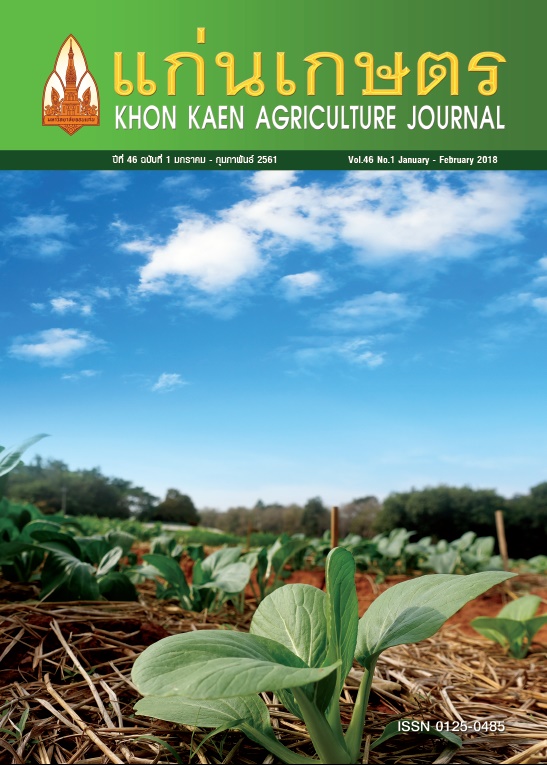Reproductive efficiency and yield responses of Valencia peanut genotypes under terminal drought conditions
Main Article Content
บทคัดย่อ
Drought at different growth stages has different effects on peanut (Arachis hypogaea L.). Terminal drought greatly affects reproductive traits and consequently reduce pod yield. The objective of this study was to determine the reproductive efficiency responses and yield of Valencia peanut genotypes under terminal drought conditions. A 2 × 9 factorial experiment consisting of nine peanut genotypes and two water regimes (full irrigation and drought stress) was used, and the treatments were arranged in a randomized complete block design with four replications at the Field Crop Research Station of Khon Kaen University, Thailand during July to October 2016. Based on flower number and number of reproductive parts, the data were recorded for the number of reproductive sink number ( hanging pegs + total pods) and number of total pods (immature and mature pods/plant) at harvest. Reproductive efficiency traits (RET), including percentage of flower to peg (RET1), percentage of the peg to the pod (RET2), percentage of the pod to mature pod (RET3) and percentage of flower to mature pod (RET4) were recorded at harvest. All Valencia genotypes had produced flowers under drought stress conditions, but they had lower conversion of flowers to economic yield. Valencia peanut genotypes have different number of reproductive traits and yield. Genotypes (ICG 14127 and ICG 10092) with high reproductive efficiency responses (RET1, RET2 and RET4) also showed high yield. Genotypes ICG 14127 and ICG 10092 with high number of mature pods/plant performed well under drought stress.
Article Details
เอกสารอ้างอิง
Awal, M.A., and T. Ikeda. 2002. Recovery strategy following the imposition of episodic soil moisture deficit in stands of peanut (Arachis hypogaea L.). J. Agron. Crop Sci. 188: 185-192.
Boontang, S., T. Girdthai, S. Jogloy, C. Akkasaeng, N. Vorasoot, A. Patanothai, and N. Tantissuwichwong. 2010. Responses of released cultivars of peanut to terminal drought for traits related to drought tolerance. Asian J. Plant Sci. 9: 423-431.
Boote, K.J. 1982. Growth stage of peanut. (Arachis hypogaea L.). Peanut Sci. 9: 35-40.
Chapman, S.C., M.M. Ludlow, and F.P.C. Blamey. 1993. Effect of drought during early reproductive development on growth of cultivars of groundnut (Arachis hypogaea L.). I. Utilization of radiation and water during drought. Field Crops Res. 32: 193-210.
Doorenbos, J., and W.O. Pruitt. 1992. Calculation of crop water requirements. In: Guidelines for predicting crop water requirements, FAO irrigation and Drainage Paper no. 24: 1-65.
Girdthai, T., S. Jogloy, N. Vorassot, C. Akkaseang, S. Wongkaew, C.C. Holbrook, and A. Patanothai. 2010. Associations between physiological traits for drought tolerance and aflatoxin contamination in peanut genotypes under terminal drought. Plant Breeding. 129: 693-699.
Gomez, K.A., and A.A. Gomez. 1984. Statistical Procedures for Agricultural Research 2nd Ed. John Wiley & Sons, New York.
Harris, D., R.B. Mathews, R.C. Nageswara Rao, and J.H. Williams. 1988. The physiological basis for yield between four genotypes of groundnut (Arachis hypogaea L.) in response to drought. III. Developmental processes. Exp. Agr. 24: 215-226.
Jin, Y., H. Yang, Z. Wei, H. Ma, and X. Ge. 2013. Rice male development under drought stress: phenotypic changes and stage-dependent transcriptomic reprogramming. Mol. Plant. 5: 1630-1645.
Koolachart, R., B. Suriharn, S. Jogloy, N. Vorasoot, S. Wongkaew, C.C. Holbrook, N. Jongrungklang, T. Kesmala, and A. Patanothai. 2013. Relationship between physiological traits and yield components of peanut genotypes with different levels of terminal drought resistance. SABRAO J. Breed. Genet. 45: 442-446.
Koti, S., K.R. Reddy, V.G. Kakani, and D. Zhao. 2005. Interactive effects of carbon dioxide, temperature, and ultraviolet-B radiation on soybean (Glycine max L.) flower and pollen morphology, pollen production, germination, and tube lengths. J. Exp. Bot. 412: 725-736.
Nageswara Rao, R.C., S. Singh, M.V.K. Sivakumar, K.L. Srivastava, and J.H. Williams. 1985. Effect of water deficit at the different growth phase of peanut. I Yield responses. Agron. J. 77: 782-786.
Nageswara Rao, .R.C., J.H. Williams, M.V.K. Sivakurumar, and D.R. Wadia. 1988. Effect of water deficit on different growth phase of peanut. II. Response to drought during pre-flowering phase. Agron. J. 80: 431-438.
Nageswara Rao, R.C., J.H. Williams, and M. Singh. 1989. Genotypic sensitivity to drought and yield potential of peanut. Agron. J. 81: 887-893.
Nautiayal, C.P., V. Ravinda, P.V. Zala, and Y.C. Joshis. 1999. Enhancement of yield in groundnut following the imposition of transient soil-moisture stress during the vegetative phase. Exp. Agr. 35: 371-385.
Nigam, S.N., M.S. Basu, and A.W. Cruickshank. 2003. Hybridization and description of the trait-based and empirical selection programs. In: Cruickshank A.W., Rachaputi N.C., Wright G.C., and Nigam S.N. (Eds), Breeding of Drought-Resistant Peanuts. pp.15-17. In: Proceedings of a Collaborative Review Meeting Held in ICRISAT Centre, ICRISAT, Hyderabad, AP, India. ACIAR Proceedings No. 112, Canberra.
Pallas, J.E., J.R. Stansell, and R.R. Bruce. 1977. Peanut seed germination as related to the soil, water regime during pod development. Agron. J. 69: 381-383.
Reddy, T.Y., V.R. Reddy, and V. Anbumozhi. 2003. Physiological responses of peanut (Arachis hypogaea L.) to drought stress and its amelioration: A critical review. Plant Growth Regul. 41: 75-88.
Songsri, P., S. Jogloy, C.C. Holbrook, N. Vorasoot, T. Kesmala, C. Akkasaeng, and A. Patanothai. 2009. Evaluation of yield and reproductive efficiency in peanut (Arachis hypogaea L.) under different available soil water. Asian J. Plant Sci. 8: 465-473.
Statistix8. 2003. Statistix8: analytical software user’s manual. Tallahassee, Florida. Turner, N.C. 1986. Crop water deficits: a decade of progress. Aust. Plant Physiol. 13: 175-190.
Prasad, V., V.G Kakani, and H.D. Upadhyaya. 2009. Growth and production of groundnut, in soil, plant growth and crop production. Verheye W.H. (Ed.), in Encyclopedia of Life Support Systems (EOLSS), Developed under the Auspices of the UNESCO, Eolss Publishers, Oxford, UK.
Prasad,V., K.J. Boote, J.R.L. Hartewell Allen, and J.M.G. Thomas. 2003. Super-optimal temperatures are detrimental to peanut (Arachis hypogaea L.) reproductive processes and yield at both ambient and elevated carbon dioxide. Glob. Change Biol. 9: 1775-1787.


